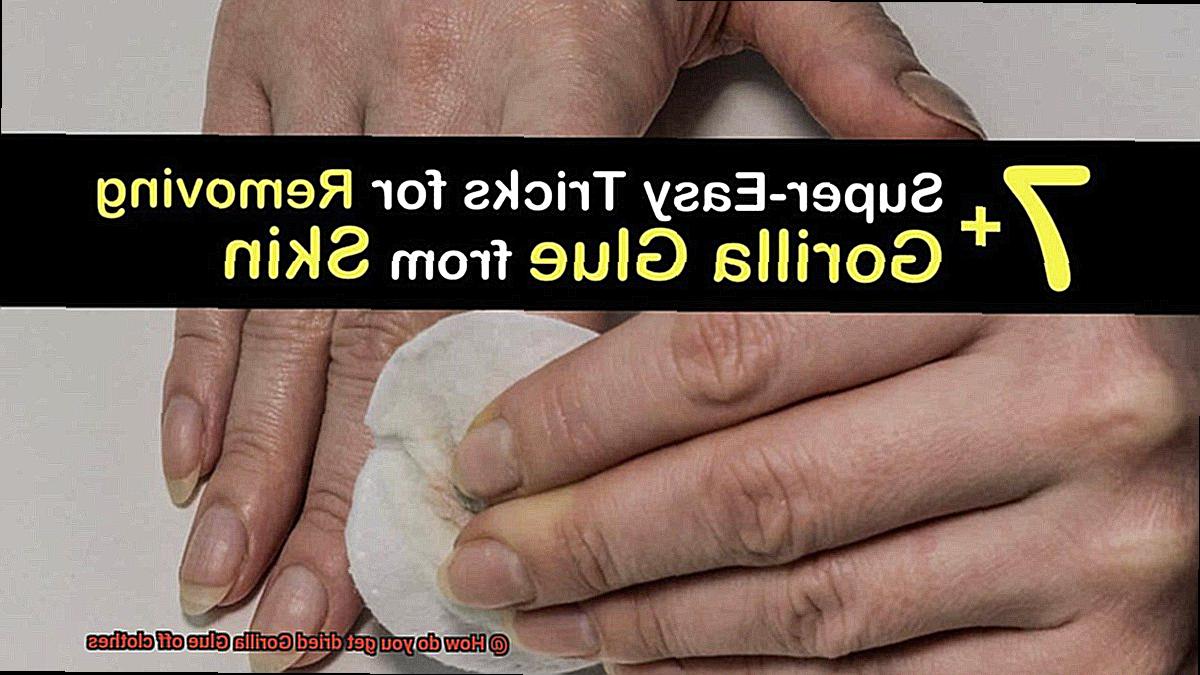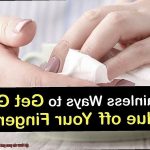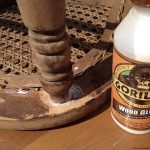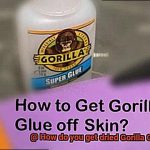We’ve all been there – a little mishap with Gorilla Glue that ends up leaving a not-so-little “glue stain” on our favorite shirt or pants. But fret not. In this blog post, we’ve got your back with some simple yet effective techniques to say goodbye to those sticky situations. Whether you accidentally spilled Gorilla Glue or found yourself wrestling with a dried patch on your clothes, we’ll walk you through the steps of removing it and rescuing your beloved garments. So, let’s dive in and discover the secrets behind getting rid of dried Gorilla Glue stains and restoring your clothing to its former glory.
We’ll start by exploring the necessary tools and materials required to tackle this sticky predicament. Then, we’ll delve into different methods and techniques for removing dried Gorilla Glue stains from various fabric types, ensuring you’re well-prepared to handle any laundry calamity that comes your way.
Stay tuned as we unveil helpful tips and tricks to make this process less daunting and more rewarding. Join us on this fascinating journey as we explore the magical world of stain removal, giving you the confidence and knowledge needed to successfully banish Gorilla Glue stains from your wardrobe for good.
Remember, prevention is the best cure. But when accidents strike, trust us to be your go-to resource for all things related to Gorilla Glue conundrums. So grab a cup of coffee, sit back, and let’s embark on this sticky adventure together.
Understanding Gorilla Glue
Contents
- 1 Understanding Gorilla Glue
- 2 Scraping off the Excess Glue
- 3 Softening the Residue with Heat
- 4 Removing the Glue with Nail Polish Remover or Rubbing Alcohol
- 5 Using Commercial Adhesive Removers
- 6 Alternative Method: Dishwashing Liquid and Water Solution
- 7 Professional Dry Cleaning
- 8 Considerations When Removing Gorilla Glue from Clothes
- 9 Conclusion
Gorilla Glue is not your average adhesive. It’s a powerhouse, renowned for its exceptional strength and durability. Whether you’re fixing a broken item, unleashing your creativity through crafting, or tackling a DIY project, Gorilla Glue is the go-to adhesive.
What sets Gorilla Glue apart from the rest is its composition. This adhesive is made of polyurethane, a substance that expands and foams when it encounters moisture. This unique property allows it to create an unyielding bond that laughs in the face of impact and moisture. When you use Gorilla Glue, you can rest assured that whatever you’re repairing or creating will stand the test of time.
But Gorilla Glue isn’t a one-size-fits-all solution. It comes in different forms to cater to your specific needs. You can choose between liquid, gel, and tape, each offering its own characteristics and benefits. No matter the form, Gorilla Glue has a remarkable ability to bond an extensive range of materials including wood, metal, fabric, ceramic, stone, and more.
Now, let’s talk about removing dried Gorilla Glue from clothes. We must tread carefully here because this adhesive doesn’t go down without a fight. Removing dried Gorilla Glue requires patience and precision to avoid damaging the fabric.
To tackle this sticky situation, follow these steps:
Begin by carefully scraping off any excess glue with a blunt knife or spoon. Be gentle to avoid causing any harm.
Soften the remaining residue by applying heat. Use a hairdryer on a low setting or an iron at a low temperature. To protect the fabric, place a cloth or paper towel between the glue and the heat source.
Now it’s time to break down the adhesive further. Apply an acetone-based nail polish remover or rubbing alcohol onto the glue spot. To prevent any unintended consequences, test this solution on a small, inconspicuous area first.
If the glue persists, consider using a commercial adhesive remover or creating your own mixture of dishwashing liquid and warm water. Apply this concoction to the stubborn glue spot and let it work its magic.
To aid in the removal process, gently scrub the area with a soft-bristled brush or toothbrush. Remember, patience is key.
Finally, rinse the garment thoroughly with clean water to remove any traces of the adhesive.
If these methods don’t completely banish the dried Gorilla Glue, it might be time to seek professional help through dry cleaning.

Remember, when dealing with dried Gorilla Glue on clothes, caution and care are paramount. Always test solvents or removers on a small, inconspicuous area before proceeding to ensure they won’t cause any damage.
Scraping off the Excess Glue
Scraping off excess glue from clothes can be a delicate task, but don’t fret. With the right tools and techniques, you can restore your clothes to their former glory. Here’s a step-by-step guide to help you tackle this sticky situation:
First, gather your tools. You’ll need a dull knife, spoon, or even your trusty fingernails to gently scrape off the excess glue. Be cautious and take care not to damage the fabric.
Now, start from the edges. Begin by carefully scraping at the fringes of the glue, gradually working your way towards the center. Take your time and exercise patience to prevent any accidental tears or snags.
If the glue refuses to budge, it’s time to soften it with warm water. Grab a clean cloth, soak it in warm water, and gently dab it onto the dried glue. This will aid in loosening its grip and make it easier to scrape off.
For those stubborn glue stains that won’t quit, bring out the big guns: rubbing alcohol or acetone. Apply a small amount of either substance onto a fresh cloth and gently rub it onto the dried glue. Let it sit for a few minutes, allowing the liquid to penetrate and soften the glue before attempting to scrape it off.
Remember, different fabrics react differently to cleaning agents, so perform a patch test on an inconspicuous area before going all-out on the stain. This will ensure that your cleaning method won’t damage or discolor your beloved garment.
Softening the Residue with Heat
Some of these methods include using rubbing alcohol or acetone to dissolve the glue, or using a commercial adhesive remover specifically designed for fabrics.
However, it is important to test these methods on a small, inconspicuous area of the fabric before applying them to the entire stain to ensure they do not cause any damage or discoloration.
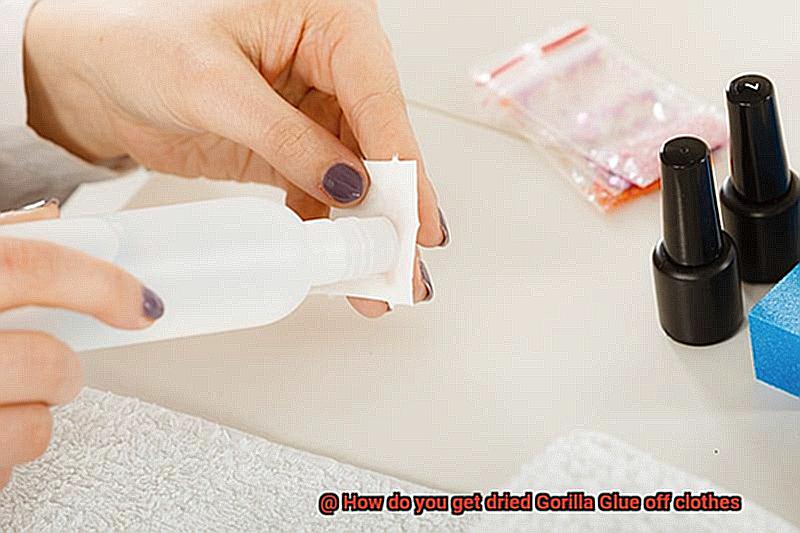
Removing the Glue with Nail Polish Remover or Rubbing Alcohol
Removing dried Gorilla Glue from clothes can be a challenging task, but with the right tools and techniques, you can restore your garments to their former glory. Nail polish remover and rubbing alcohol are both effective solutions for tackling this sticky situation.
Before you begin, it’s crucial to check the care label on your clothing item. Ensure that it can withstand the use of solvents like nail polish remover or rubbing alcohol. Once you’ve confirmed, follow these steps for successful glue removal:
- Protect other parts of the garment: Place a clean cloth underneath the stained area to prevent the glue from spreading or transferring to other parts of the fabric.
- Moisten a cotton ball or clean cloth: Dip a cotton ball or soak a clean cloth in nail polish remover or rubbing alcohol. Make sure it’s damp but not dripping.
- Gently blot the affected area: Begin blotting the glue with the moistened cotton ball or cloth. Avoid rubbing, as this can push the glue deeper into the fabric fibers. Instead, gently dab and lift.
- Continue blotting: Keep blotting until you notice the glue starting to soften and come off. You may need to apply more nail polish remover or rubbing alcohol as necessary. Be patient and persistent in your efforts.
- Rinse with cold water: Once the glue has been removed, rinse the garment with cold water to wash away any remaining solvent and residue.
- Launder as usual: After rinsing, launder the clothing item as you normally would. This step will help eliminate any lingering odor or residue from the solvent.
Remember, prevention is key. If you’re working with Gorilla Glue for crafting or repairs, take precautions to avoid getting it on your clothes in the first place. And always test any solvents or adhesive removers on a discreet patch of fabric before applying them to larger areas.
Using Commercial Adhesive Removers
Using commercial adhesive removers is a common and effective method for removing adhesives from various surfaces. These removers are specifically designed to break down the bonds of adhesives, making them easier to remove. Here are some key characteristics and considerations when using commercial adhesive removers:
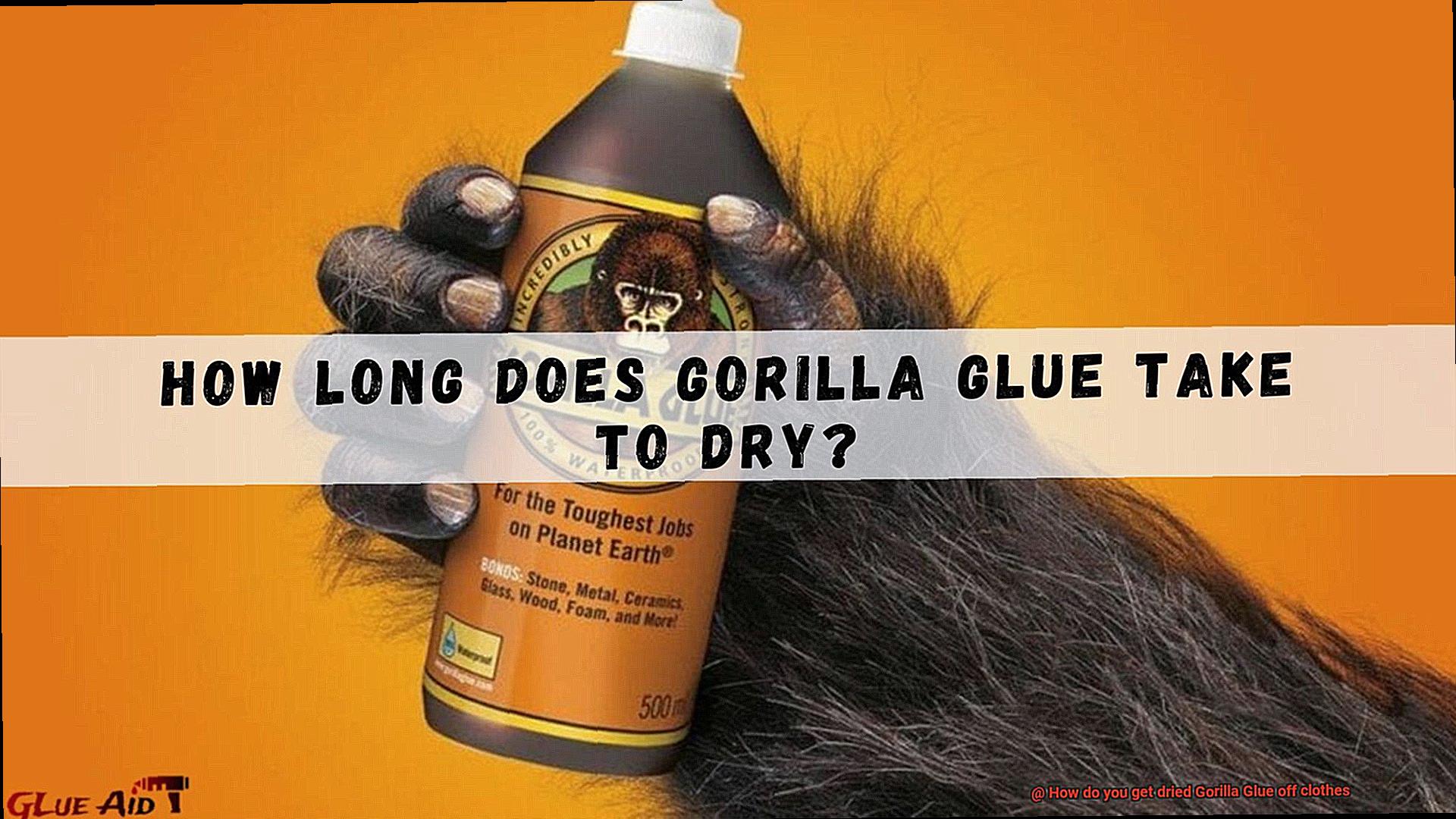
- Types of adhesive removers: Commercial adhesive removers come in various forms, including liquids, gels, sprays, and wipes. The type you choose may depend on the surface you are working on and personal preference.
- Solvents: Commercial adhesive removers contain solvents that help dissolve the adhesive. Common solvents include acetone, citrus-based solvents, and petroleum-based solvents. It’s important to select a remover that is compatible with the surface you are working on to avoid damage.
- Safety precautions: When using adhesive removers, it’s essential to follow safety precautions. This includes working in a well-ventilated area, wearing protective gloves and eyewear, and avoiding contact with skin or inhaling fumes. Some products may also be flammable, so keep them away from open flames or heat sources.
- Testing: Before applying the adhesive remover to a larger area, it’s recommended to test it on a small, inconspicuous spot to ensure it doesn’t damage or discolor the surface. This is particularly important for delicate fabrics or sensitive materials.
- Application: Apply the adhesive remover directly onto the adhesive or onto a cloth or sponge before rubbing it onto the surface. Allow the remover to penetrate the adhesive for a few minutes to break down its bonds.
- Removal process: After the adhesive has been loosened by the remover, use a cloth or scraper to gently remove the residue. It may require some rubbing or scraping depending on the strength of the adhesive.
- Cleaning and rinsing: Once the adhesive has been removed, clean the surface with soap and water to remove any residue from the adhesive remover. Rinse thoroughly and dry the surface completely.
Popular brands of commercial adhesive removers include Goo Gone, 3M Adhesive Remover, and Goof Off. Each brand may have its own advantages and disadvantages, so it’s important to read reviews and choose the one that best suits your needs.
Alternative Method: Dishwashing Liquid and Water Solution
Accidentally getting dried Gorilla Glue on your favorite clothes can be a nightmare. But fear not. There’s a simple and affordable solution you can try at home. In this article, we will explore an alternative method using a dishwashing liquid and water solution to remove dried Gorilla Glue from clothes. This method is effective for most fabrics and can save you from the hassle of purchasing commercial adhesive removers. So let’s dive in and rescue your garments.
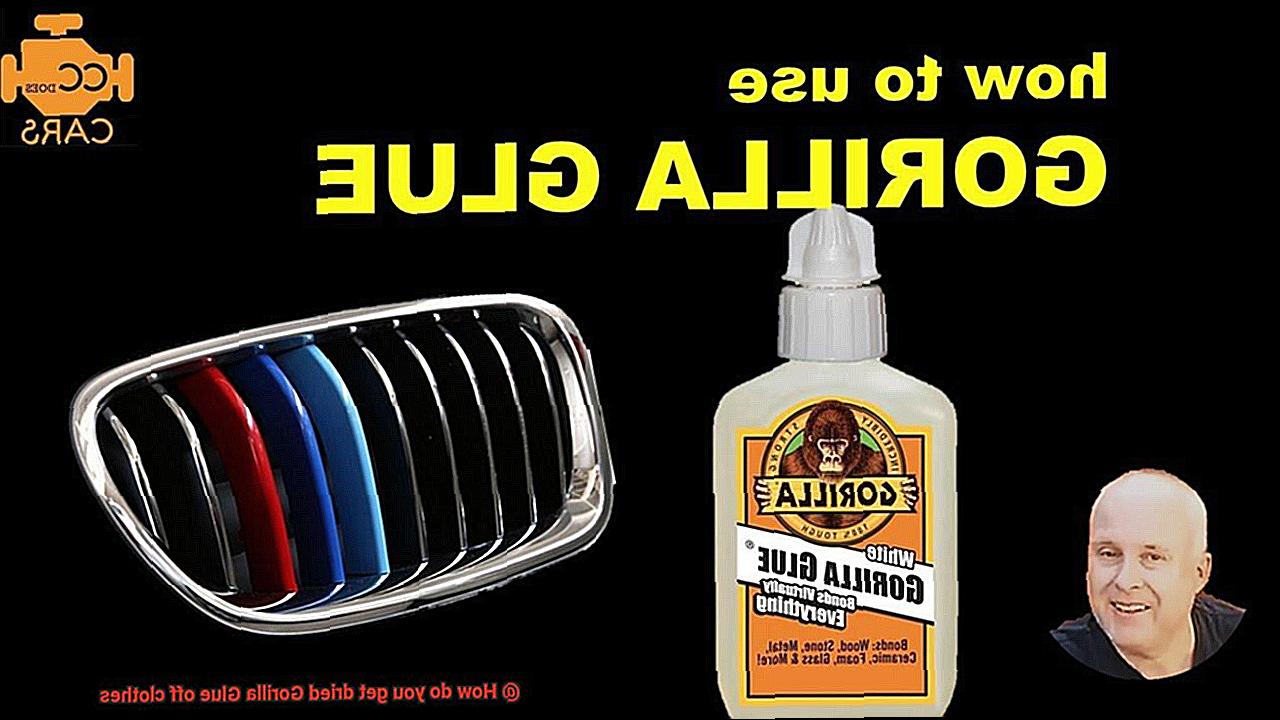
Materials Needed:
- Warm water
- Dishwashing liquid
- Bowl or basin
- Soft-bristled brush or toothbrush
- Clean cloth or sponge
- Water source for rinsing
Step-by-Step Guide:
- Prepare the Solution: Start by mixing warm water with a few drops of dishwashing liquid in a bowl or basin. The warm water acts as a gentle softener, while the dishwashing liquid works as a powerful degreaser.
- Soak the Affected Area: Submerge the affected area of the clothing in the solution for at least 15 minutes. This allows the dishwashing liquid to penetrate the dried glue, loosening its grip on the fabric.
- Gently Scrub the Area: After soaking, take a soft-bristled brush or toothbrush and carefully scrub the area using circular motions. This delicate agitation helps to further weaken the glue’s bond with the fabric.
- Rinse Thoroughly: Once you’ve scrubbed the area, rinse the clothing thoroughly with clean water to remove any lingering soap residue.
- Repeat if Necessary: If some glue residue remains, don’t panic. Simply repeat the process or try using a slightly stronger concentration of dishwashing liquid. Just remember to be cautious not to damage the fabric while scrubbing.
- Test Before Proceeding: Before applying the dishwashing liquid and water solution, it’s crucial to test it on a small, inconspicuous area of the clothing. This simple step ensures that the solution won’t cause any damage or discoloration.
- Seek Professional Help if Needed: For delicate fabrics or clothing with special care instructions, it’s always wise to consult a professional cleaner or tailor for assistance. They have the expertise and tools to handle tricky situations.
Professional Dry Cleaning
Professional dry cleaning is a specialized method of cleaning clothes that uses non-water-based solvents to remove stains and dirt. It is particularly useful for tackling tough stains like dried Gorilla Glue, known for its strong adhesive properties. A professional dry cleaner has the necessary equipment and expertise to handle different types of stains and fabrics, making them a reliable choice for restoring clothes to their original condition.
When taking your clothes to a professional dry cleaner, it is important to inform them about the presence of dried Gorilla Glue. This allows them to take appropriate measures and use specialized solvents specifically designed for removing adhesives. The dry cleaning process typically begins with pre-treating the stained area using the appropriate solvent. This solvent effectively breaks down the adhesive properties of the glue without causing damage to the fabric.
After pre-treatment, the clothes are placed in a specialized dry cleaning machine that uses non-water-based solvents to thoroughly clean the garments. These solvents dissolve and remove stains, dirt, and any remaining traces of Gorilla Glue. It is important to note that not all fabrics are suitable for dry cleaning. Delicate fabrics like silk or wool may require alternative methods of stain removal to prevent damage. A reputable dry cleaner will assess the fabric’s suitability and suggest alternative solutions if necessary.
Once the dry cleaning process is complete, it is essential to inspect the clothes thoroughly. Check for any remaining traces of dried Gorilla Glue to ensure it has been successfully removed. If any residue is found, inform the dry cleaner so they can take additional measures.
Although professional dry cleaning may be more expensive than other stain removal methods, it offers a reliable solution for removing dried Gorilla Glue without causing further damage or discoloration to your clothes. When choosing a dry cleaner, opt for a reputable one with experience in handling adhesive stains. This ensures that your clothes are treated with care and that the best results are achieved.
Considerations When Removing Gorilla Glue from Clothes
Removing dried Gorilla Glue from clothes can be a daunting task, but with the right techniques and precautions, you can save your favorite garments. In this article, we will explore the considerations to keep in mind when removing Gorilla Glue from clothes.
Fabric Type:
Different fabrics react differently to solvents and cleaning methods. Before attempting to remove Gorilla Glue, check the care label of the clothing item for specific instructions or restrictions. This will help you choose the appropriate method without causing further damage.
Acetone:

Acetone is a popular choice for removing dried Gorilla Glue from clothes. However, it can harm certain fabrics like acetate or rayon. Perform a spot test on a small, inconspicuous area before applying acetone to the glue stain. Work in a well-ventilated area, wear gloves, and protective eyewear to avoid direct contact with skin and eyes.
Isopropyl Alcohol:
Isopropyl alcohol is a milder alternative to acetone. Apply it to a clean cloth and gently dab the glue stain. Allow it to sit for a few minutes before scraping off the softened glue. This method is safer for delicate fabrics.
Warm Soapy Water:
Another alternative is warm soapy water. Soak the affected area in warm soapy water for about 15 minutes to loosen the glue. Gently scrub the stain with a soft brush or toothbrush, then rinse thoroughly with clean water. This method is suitable for most fabrics and does not involve harsh chemicals.
Persistence:
Stubborn stains may require multiple attempts or alternative methods. Be patient and persistent while working on removing the glue stain. It may take some time and effort, but it is possible to achieve success.
Professional Assistance:
If all else fails or if the fabric is delicate, it is best to consult a professional cleaner or tailor who specializes in removing tough stains. They have the knowledge and experience to handle delicate fabrics without causing damage.
Prevention:
Prevention is always better than cure. To avoid accidental spills or stains, wear old clothes or aprons while working with Gorilla Glue. Cover nearby surfaces with protective materials to prevent any mishaps.
QYmZSDjLQ9A” >
Conclusion
In conclusion, removing dried Gorilla Glue from clothes is no easy feat. But fear not, for there are tried and true methods to salvage your beloved garments from this sticky predicament.
Scraping off the excess glue is a good starting point. Gently wield a blunt tool to chip away at the hardened adhesive, being careful not to damage the fabric beneath.
Another approach involves harnessing the power of heat. Soften the residue by placing a clean cloth over the affected area and applying a warm iron on low heat. The glue should begin to loosen, making it easier to remove.
For more stubborn stains, nail polish remover or rubbing alcohol can come to the rescue. Dab a small amount onto a clean cloth and gently blot at the glue until it starts to dissolve away.
If these DIY methods don’t quite do the trick, commercial adhesive removers are readily available. Follow the instructions carefully and proceed with caution, taking into account any potential effects on your specific fabric type.
In some cases, concocting a solution of dishwashing liquid and water can work wonders. Apply this mixture directly onto the glue stain and let it sit for several minutes before gently scrubbing with a soft brush or sponge.
Remember, before embarking on any removal method, always consider your fabric type and conduct spot tests in inconspicuous areas. Patience and persistence are essential when dealing with stubborn stains – don’t give up too easily. And if all else fails or you’re dealing with delicate fabrics, seeking professional assistance may be your best bet.
Prevention is key when working with Gorilla Glue. Donning old clothes or aprons and protecting nearby surfaces will save you from accidental spills or unsightly stains.
Armed with these tips and techniques, you can confidently bid farewell to Gorilla Glue mishaps and restore your clothes to their former glory.

